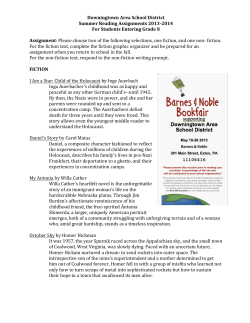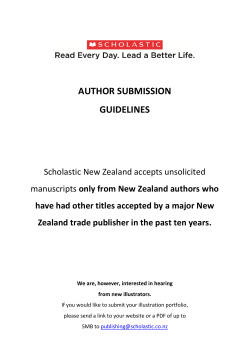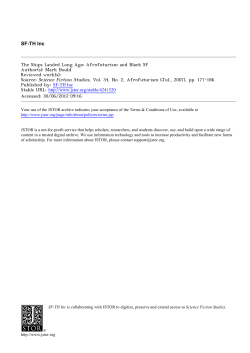
1 Barbara Fister Iowa Library Association Meeting, October 23, 2014
1
The Mystery of It All: Why We Enjoy Crime Fiction
Barbara Fister
Iowa Library Association Meeting, October 23, 2014
Abstract: Why is crime fiction so popular? Why do we enjoy being made anxious by violence that
we would never want to encounter in real life? Why do women, in particular, read so many
books about sexualized violence? What’s going on? We’ll take a look at the way the genre helps
us negotiate social anxiety and dig deeper into the world when the news just doesn’t make
sense, consider what we know about the psychology of reading for pleasure, take a look at what
we can learn from online reading communities, and hear about one librarian’s experience
writing mysteries.
It’s great to be able to be here today to talk with you all about something I love. I won’t call it a
guilty pleasure because I refuse to feel guilty about it. I just love to read crime fiction. I love it so much
I’ve written a few mysteries myself. Tonight, I’m going to try to explain why this genre appeals so much
to me and to countless others and make some claims for its value as well as explore what it tells us
about ourselves. Though I am an academic librarian, one of my interests is the ways that popular fiction
can contribute to this thing all academic librarians want to believe we are doing: that when we help
students learn, it will contributes to our students’ capacity for lifelong learning. Our students like to
read for pleasure but don’t do much of it during the academic year because they have so much assigned
reading and busy social lives, but we do what we can to encourage reading for pleasure and to help
them develop their own personal reading tastes.
I learned a long time ago that you could learn a lot from mysteries. My mother was a walking
encyclopedia. She knew everything. If we needed to know when a battle was fought or what a Latin
phrase meant or what exactly happened to Charles the second, anyway, she knew the answer (though
as part of her own educational mission she often told us to look it up in the encyclopedia). She had a
terrific general education that was largely through reading. She was a child of the depression and had to
leave school when she was sixteen to go to work. She never finished high school but was educated
through books – and mysteries were her genre of choice.
This impression I formed early on, that we must absorb a great deal of knowledge through
pleasure reading, was borne out by the research Catherine Sheldrick Ross and her graduate students did
on the lived experience of avid readers. After interviewing over 200 readers, they found that reading
popular fiction could be affirming (“there are other people in the world like me”), a way of learning
about the world that’s inaccessible in real life, and that it contributed to their capacity for creativity and
problem-solving. This led Ross to urge librarians to explore not just information seeking behavior, but
the importance of information encountering, which I think is a profoundly important insight.
Psychologists have also had interesting things to say about the effects of reading for pleasure.
Victor Nell studied the trance-like state of mind when lost in a book. His neurological studies suggest
that the brain is extremely busy when we appear to be passively consuming a story. Our brains are busy
constructing with the author a fictional world. Keith Oatley and others have conducted experiments
that found that those who read narrative stories score better on tests for empathy than those who don’t
2
He hypothesizes that fiction exercises empathy by serving as a simulator for experiences, which
develops our capacity for understanding. All of this is a good reminder to pay attention to diversity in
our collections and make sure we have books that reflect the experiences of people of color and
different gender identities and social statuses. As someone recently reminded me on Twitter, this is not
just so that white readers’ horizons will be expanded, though that’s all good, but also so that non-white
readers aren’t always simulating the experiences of people whose lives are not theirs – practicing
empathy for those who have privilege. We need both empathy with others and the ability to find
ourselves in our reading experiences.
Another psychologist of reading, Richard Gerrig, found that readers’ brains don’t shelve fiction
separately from non-fiction. What we encounter in fiction becomes part of our knowledgebase unless
we know better. That is, a biblical scholar might enjoy The Da Vinci Code, but it won’t alter her
understanding of church history. A less informed reader is more likely to take it as fact. Now, this is
slightly alarming to me. This all supports the claim that fiction matters, that it forms an important part of
our knowledgebase – but it also puts a burden on writers to get things right: emotionally, factually, and
socially.
That brings us to crime fiction, a broad category that embraces mysteries from cozy to
hardboiled, thrillers, crime capers, and noir – any stories involving crime. It’s an enduringly popular
choice for readers. Though steamy potboilers about the lives of the rich and famous were more likely to
be on the bestseller list until the 1990s, when crime fiction took over, we’ve enjoyed crime since the
days when Elizabethan pamphlets about notorious crimes were sold on the street. Though steamy is
definitely back on the bestseller list, mysteries and thrillers continue to be popular. Why are stories
about crime still so fascinating when our violent rate has been halved since the 1990s? Why do so many
mysteries focus on young white women as victims of violence when in reality the murder rate for young
black women is four times that of young white women and 78 percent of homicide victims are male? (Of
course the women-in-danger theme is hardly new. It was popular in the pulps of the 1930s.) But since
the 1990s In fiction we’ve seen an epidemic of serial homicide and stranger abductions, but in reality
both crimes are rare. Why are we entertained by fear that is exaggerated? Why do we focus on threats
that are so unlikely?
It’s probably in part the same impulse that puts grotesque crimes on the front page of the
newspaper: if it bleeds, it leads. Stories that are unsettling are also compelling so long as the threat itself
is more imaginary than real, when we can identify with the victim, yet feel the violence they experience
is an aberration that won’t likely happen to us. In narrative form, crime can be contained. It poses
problems that we trust will be solved, and that fictional resolution reassures us about anxiety that is
otherwise uncomfortable. Readers frequently say that they like mysteries because it conveys the sense
that justice is restored. According to critic Catherine Nickerson, the genre is both stimulating and
soothing. It deals with explosive materials within a safe space where there are formulas to follow, where
we know what to expect (including a certain measure of surprise). It’s a genre that allows us “to draw
close to the flame of our culture’s evils without actually getting burned.”
One of the reasons why this genre is so popular is that it offers such a wide range of choices.
There’s a spectrum from very light to gruesomely dark; there’s also a lot to choose from in terms of
focus, from the sociological (taking a Dickensian wide-angle view of violence), to the psychological
(seeking explanations for deviance within people’s inner lives) to the mythological (framing the story as
3
a Manichean battle between the forces of good and evil). I myself am wary of the latter, particularly in
its willingness to attribute crime to monstrous others. This framing too often makes crime a matter of
personal moral choice or some kind of genetic aberration that lets us off the hook because we then feel
no responsibility for situations that in real life contribute to crime and violence. People don’t kill people,
monsters do.
The suspense in the crime genre draws on things that frighten us as a society. Which is
interesting, because anxiety is a potent factor in the formation of social issues. Our fears are often
manipulated by various groups to amplify their cause. For example, the media, which needs exciting
stories to recruit and retain their audience. But we often fail to focus on what’s really important. Last
year, two trials concluded in the same week. In one, a woman in Arizona was found guilty of killing a
man. In the other, a man in Guatemala was found guilty of killing 200,000 people. Only one of these
trials got significant news media attention in the US even though the Rios Montt trial for genocide was
live-streamed, available to anyone who wanted to listen in. Why didn’t we cover it? It was messy. Our
government had been involved in the coup that led to the genocide, and that would be hard to explain.
It involved too many victims, mostly indigenous people, so the story would be both upsetting and hard
to wrap our heads around. And it wouldn’t reach a satisfying conclusion. A higher court overturned the
conviction ten days later. Though Rios Montt still faces charges, he won’t be back in a courtroom until
next year. While one narrative was dramatic, the other was simply complex, upsetting, and presumably
less likely to recruit and retain the attention of American audience and generate ad revenue.
The state also uses anxiety to gain support for the regulation of behavior. We can take the serial
killer threat as an example. At the beginning of Ronald Reagan’s administration, the Department of
Justice wanted to repair the reputation of law enforcement, frayed after Watergate and the Church
Committee investigation into decades of illegal surveillance of dissidents. The FBI made a startling
announcement: the rate of serial homicides had jumped alarmingly to 25 percent of all murders. Later
they retracted the statement. They had accidentally classified all homicides for which the victimperpetrator relationship was unknown as the work of serial killers. Oops! But the highly-inflated figures
and the sense of growing threat helped restore trust and budgets. It also aligned with the kinds of
stimulating yet soothing narratives people craved at the time, which made Hannibal Lector such a hit
and enabled James Patterson to mass produce serial killers to such popular effect. (Philip Jenkins, Using
Murder.) Now, of course, we have to sustain an endless war on terror, which requires being afraid. Very
afraid.
All three of my mysteries have been about the way fear is manipulated to produce a common
social response to threat. In On Edge, residents of a small town, once coaxed into a frenzy of accusation
over satanic abuse charges, are being whipped up again when three children are murdered. In the Wind
plays off the parallels between the civil liberties abuses of the Vietnam War era and the Bush era, fear of
Communism converted to fear of Muslim extremists nurtured to excuse unconstitutional practices.
Though the Cracks deals with a fear that strikes closer to home, the fear every woman is raised to feel in
her bones, a fear that constricts our freedom and blames us for our sexuality. Fear of sexual assault.
The idea for Through the Cracks first came to me years ago when I read an investigative series in
the Chicago Tribune on the shocking number of exonerations of Illinois death row prisoners. Many of
them involved confessions obtained by detectives working under a Chicago PD commander who valued
convictions more than truth. I was, of course, appalled that innocent men had been falsely imprisoned,
4
but I was mostly outraged for the victims of those crimes. Grabbing some guy off the street at random
to make a conviction instead of pursuing the case with integrity seemed the ultimate way of saying to
the African American community of Chicago “you don’t matter.” I also wondered what it was like for
victims to learn the men they thought responsible were possibly innocent, and the person who had
knocked their life off-kilter wasn’t locked up after all.
As I started working on the story, I faced a challenge. Threats to women – the threats that
constrict our lives on a daily basis – are frequently the subject of crime fiction, used to provide that
pleasurable thrill that we all crave. But I didn’t want to sexualize violence against women. I wanted to
treat it as it really is: violence in the service of oppression.
Thousands of books use scores of women as throwaway props for a clever killer who is engaged
in a duel of wits with a heroic detective. We are often promised a glimpse of pure evil as we are invited
to step into the mind of serial killer. This is an entertaining way to reassure ourselves that we are not
monsters, that when bad things happen to good people, we know who to blame, and it’s not us.
I don’t mind reading or writing about violence, but I want it to be honest. To me, the reality-free
serial killer story is less honest that the fluffiest of cozies. Real crime involves real causes: inequality,
poverty, racism, hopelessness, greed, jealousy, the indifference of a culture that devours news stories of
stranger abductions but is bored by the fact that one in five of our children live in poverty, that enjoys
stories about the serial slaughter of young women but is reluctant to acknowledge the existence of rape
culture. Admittedly, real life is relatively dull and big problems are harder than dramatic ones. Like
others, I read crime fiction for fun, not to be educated or to hear earnest lectures. But I’m bothered by
the way women are trivialized by fantasy crimes, and for that reason I’m thrilled that so many people
have taken Lisbeth Salander to heart. Who would have thought that a book that, in the original, had the
title Men Who Hate Women and starts chapters with social statistics about misogyny could possibly be a
bestseller in this country? Not to mention generate perhaps my favorite title in our lit crit section.
Stieg Larsson won readers over by giving them the sense that justice is possible through the
actions of heroic characters who refuse to put up with injustice. Rather than be a traumatized victim
who lives in fear, Salander stands up for herself when society won’t, and it’s that stance, not the threats
against her, that is exhilarating. The Millennium Trilogy distinguishes itself, too, in situating violence in
social systems that tolerate inequality and are easily manipulated by powerful men. Larsson remixes a
variety of genre conventions to expose social structures in which evil isn’t a monstrous Other, but the
actions of powerful individuals who routinely make self-serving choices, capturing our sympathy with a
compelling heroine whose task is to expose and confront our assumptions.
Larsson chose to make a political argument fun by remixing every kind of crime fiction narrative:
the nutty serial killer with a Nazi past, the locked room mystery, the dysfunctional family saga, the spy
thriller, the financial thriller, the police procedural, the political thriller, and the courtroom drama,
creating a remix of popular culture motifs that becomes an imaginative landscape within which he can
work through the issues of inequality and racism that he dealt with in his journalism.
But that boundary between engaging serious issues and entertainment can be a fraught place.
South African journalist and novelist Margie Orford has written about why she turned to writing crime
fiction. She writes:
5
The nature of crime and its effects seemed to elude me in many articles I wrote on the
subject. I could list the shocking facts, but in the limited space of a one- or two-thousand
word piece, I felt that I could never get to the truth about crime, about social
dislocation, modernity and violence, and what this says about South Africa and those of
us who live here. It is only in fiction that I could begin to find the voices of the brutalised
and the dead . . . The crime novel, if done well, is a way of interpreting the society upon
which it focuses its lens.
That said, Orford is troubled by the fact that there is a lot of misogyny in the genre and it’s difficult to
avoid the erotic charge of the damaged female body given how woven into the genre it is. She also
found herself troubled by the risk of oversimplifying the silencing power of violence:
I am at a loss as to how to engage fictionally, in an ethical manner, with the incomprehensible
complexity of violence of South Africa. I may have erred profoundly in imagining that fiction
might be a means of finding a way back, after the obliterating effects of violence, to some
semblance of a language: a different language, an empathic language, a language that speaks of
resilience and survival.
I actually think she’s done rather a good job of helping readers like me think about violence in her
country and all of the complexity that has gone into it, but I sympathize with the challenge this kind of
fictional honesty poses. The restoration of justice that we crave in our fiction is sometimes too easy an
out. I think she’s put her finger on a defining ethical issue for both writers and readers of the genre.
Finally, what I’d like to talk about briefly is the subject of my current research: how reading is
both deeply solitary and at the same time social. Francis Spufford, author of The Child that Books Built,
described reading as a child as a form of separation from the world. “As my concentration on the story
in my hands took hold, all sounds faded away . . . there was an airlock in there. It sealed to the outside
so that it could open to the inside.” For him, reading books was a very personal journey and an escape.
Students who have taken a course I have taught on books and culture have said similar things about the
way their personal identities are entwined with the books they read. As one put it, “My bookshelf is not
just a bookshelf. It’s a time warp.“ Each book returned her to a particular time in her past. Yet as
Elizabeth Long pointed out in her 2003 study of book groups, reading is also a social practice. That social
connection often begins with childhood reading experiences. As another student put it, “It was an
ordinary place in our house growing up, but it became magical every night when my mom would sink
into the soft cushions with a book in her hands. My younger sister and I would sit on either side of her
resting our heads against her arms, peering at the illustrations that transformed our living room. My
mom’s voice would decode the squiggles on the page into words, into a story. My first memory of books
comes from this spot in our living room.”
Today, that social life of books and readers is inscribing social media with an almost limitless
conversation about books. Millions of readers around the world participate in online communities
focused on sharing their reading experiences. They formed early in the history of the Internet – DorothyL was founded in 1990. Rec.alt.mysteries (also known as RAM) was a Usenet group that was founded in
the early 90s. Compuserve had active mystery discussion groups. Yahoo Groups has hosted thousands of
6
book-related groups over the years. I studied one of those reading communities back in 2005 and found
that the combination of sharing a love of the mystery genre and having a sense of community with likeminded readers scattered across the globe was highly valued by its members. Since then, sites like
Goodreads (with 30 million members), LibraryThing (1.8 million members) as well as book discussions
held on Facebook, Twitter, LinkedIn, Tumblrs and blogs have all flourished.
I always find it puzzling when pundits say “nobody reads these days” or “reading is on the
decline” given the evidence that millions of readers thrive on sharing their experiences with reading for
pleasure. It’s also clear from observing these social interactions that they feel their reading experiences
benefit from social interactions, that readers form interpretive communities that transcend national
boundaries and other differences, and that these informal critical communities play a critical role in the
the formation of popular literary tastes which, in turn, are shaped by and shape our understanding of
the world we live in. Wattpad is an interesting place where storytelling and sharing come together. On
this site, people serially share stories for free, collecting reading communities that comment on the
stories as they evolve. If you’ve read Rainbow Rowell’s Fangirl, you probably have a sense of why 35
million people participate. Last week a 25-year-old member sold film rights to a series of romances she
posted there which, over the course of time, have collected a billion views. This is an perhaps an
extreme version of reading and writing as a social act, but is an illustration that storytelling and reading
are popular when shared.
Libraries, of course, may be the original place where reading was seen as a social act. Libraries
contribute enormously to this communal sense that reading is not simply a solitary pleasure (one
characterized as a guilty one indulged in by indolent women in the early 20th century when it was called
“the fiction problem”). Nor is it an act of individual consumerism indulged in for free. It’s a communal
experience, one that libraries encourage and support, an ongoing conversation with readers that
enables what Wayne Wiegand has described as democracies of culture ("The Politics of Cultural
Authority." American Libraries (1998): 80-82). These are spaces where we let our communities decide
what matters and experience the identification and the expanded world view that reading imaginative
literature enables. The only gates we keep are open ones. We defend the commons, and in supporting
the common reader whose tastes likely run to crime fiction, we are helping our communities experience
the mystery of it all.
© Copyright 2025










